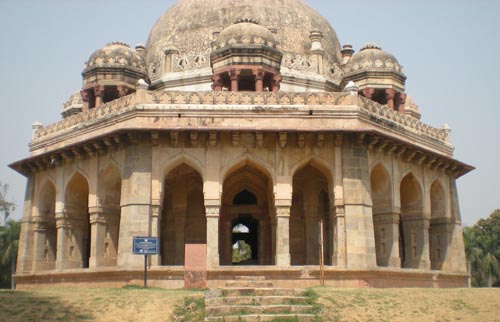Muhammad Shah's Tomb

Information on Muhammad Shah's Tomb (New Delhi) - History & Architecture
The tomb of Mohammed Shah is located in a popular park, Lodi Gardens in Delhi. The Lodi Gardens is spread over an extensive area of more than 90 acres and includes quite some popular historical monuments within the complex such as Sikander Lodi's Tomb, Bara Gumbad, Sheesh Gumbad and Mohammed Shah's Tomb. These sites are maintained and looked after by the Archaeological Survey of India (ASI). The Lodi Gardens is located amid the Safdarjung's Tomb and Khan Market and is also supposed to be a well-liked spot among the morning walkers of Delhi.
The mausoleum of Mohammed Shah is learnt to be amongst the initial mausoleums in the Lodi Gardens. Mohammed Shah was the last reigning ruler belonging to the Sayyid dynasty. The tomb was learnt to be constructed by Ala-ud-din Alam Shah in the memory of the monarch and also as a mark of respect to Mohammed Shah. The tomb of Mohammed Shah can be easily spotted from the main road.
Muhammad Shah's Tomb Architecture
The tomb of Mohammed Shah was constructed in the year 1444. The design of the tomb reflects an influence of both the Lodi & Saiyyid styles of architecture. The design of the tomb comprises a huge octagonal compartment which further includes a soaring elegant dome on the top and is encircled with an open airy pillared verandah which runs correspondingly towards the sides. The noteworthy elements with regard to the architectural pattern demonstrated on the tomb include an uninterrupted eave or a "chajja" by the side of roof which is held up with the help of brackets, chattris or rather an arched roof installed on slim pillars at equal intervals. The chattris are observed to be elevated on the fortifications above each of the sides, sturdy or well-built pillars in grey quartzite stone run besides the individual corners with respect to the octagon along with three-arch entry points on the sides of the verandah and an upturned ornamental lotus placed on the top of the main dome are few of the typical features that are associated with the structures of the stated period. It needs to be mentioned in this context that the archetypal Afghan pattern dome, bouquets placed on the top of the corners and beside the drum angles along with the slanting brickwork of structures are considered to be the significant architectural as well as ornamental characteristics of the structure. The tomb houses eight graves among which the one in the centre is identified to be of Mohammed Shah's.
Muhammad Shah's Tomb History
The mausoleum of Mohammed Shah is of immensely significant from the historical view point as the tomb is the oldest of its kind among the others in Lodi Gardens. Mohammed Shah was a ruler from the Sayyid dynasty and the Lodi era in India commenced from around 1451 which was just subsequent to the Sayyid dynasty. Mohammed Shah was also known by the name of Roshan Akhtar and was a Mughal ruler who ruled India from 1719 to 1748. He was the grandson of Bahadur Shah I and the son of Khujista Akhtar Jahan Shah. Mohammed Shah became a king at the tender of just seventeen with the assistance of Husayn and Abdullah Ali, the Sayyid brothers. The Mughal empire ultimately disintegrated into numerous regional states with individual rulers for every state, thus greatly bringing down the power of Mohammed Shah.
Muhammad Shah's Tomb Tourism Significance
Lodi Gardens is known to be a place of conservation and therefore, attracts a huge number of people globally as well as locally. Visitors become keen to visit the mausoleum of Mohammed Shah as it can be spotted from the main road and is believed to be the oldest structure in the Gardens.
- Andaman Nicobar Monuments
- Andhra Pradesh Monuments
- Assam Monuments
- Bihar Monuments
- Chhattisgarh Monuments
- New Delhi Monuments
- Goa Monuments
- Gujarat Monuments
- Haryana Monuments
- Himachal Pradesh Monuments
- Jammu and Kashmir Monuments
- Karnataka Monuments
- Kerala Monuments
- Madhya Pradesh Monuments
- Maharashtra Monuments
- Odisha Monuments
- Punjab Monuments
- Rajasthan Monuments
- Tamil Nadu Monuments
- Telangana Monuments
- Uttar Pradesh Monuments
- West Bengal Monuments